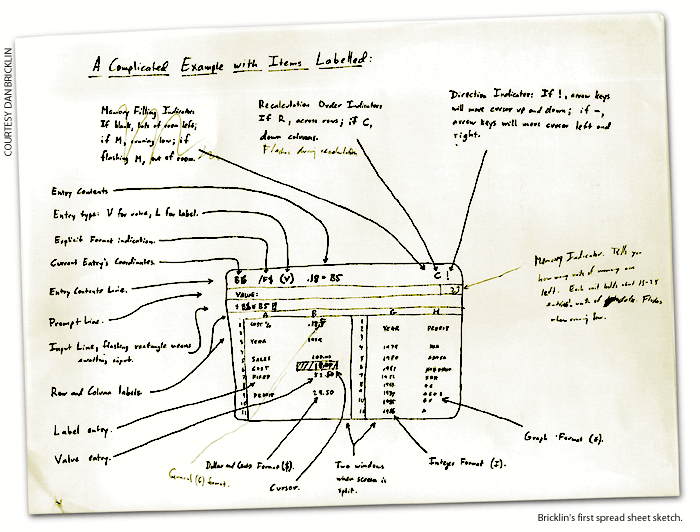One of the coolest experiences I had at Harvard Business School was stumbling across a dusty plaque that hung on the wall of one my classrooms–Aldrich 108. The plaque had an image that read: “In this room in 1978, Dan Bricklin conceived of the first spreadsheet program. VisiCalc, original ‘killer app’ of the information age, forever changed how people use computers in business.”
The image below is one of Dan’s earliest sketches of VisiCalc, the first ever spreadsheet.

Why share this story at the beginning of an article about using Salesforce to calculate sales commission? The invention of spreadsheets was a huge step toward commission automation. Salesforce was the next.
A few years ago, the current state of the art commission solution was to use Salesforce + Excel. That’s how most organizations were processing commission payments.
But, then, we experienced another seminal change in business software. Today, we explore the evolution of commission software.
A Brief History of Salesforce
We started this article talking about the invention of VisiCalc, the first spreadsheet. Spreadsheets are still, in my opinion, the most successful business software ever created. The second most successful business software, after Excel, is Salesforce (source).
Salesforce started 20 years after VisiCalc, in 1999. The company was a pioneer in Internet-delivered software as a service, or SaaS. It almost completely demolished its largest, non-Saas competitor, Siebel Systems, over a period of five to six years.
Salesforce brought all of the benefits of modern enterprise software over spreadsheets. Salesforce does many things well but one pain point users continue to struggle with is commission management. (True, I’m biased.) So I’m going to walk you through an example of creating your commission calculations in Salesforce.
How To Calculate Commission In Salesforce
If you’re reading this article, it’s likely that you already have your instance of Salesforce set up. As amazing as Salesforce is, it’s a relatively heavy lift to implement- particularly for new or small organizations. And, not to be the bearer of bad news, but building a commission system in Salesforce is an equally heavy lift. Building a system to calculate commission in Salesforce requires the following:
- Building custom commission objects
- Adding custom attributes to those commission objects (ex. commission amount)
- Adding custom formulas that automatically calculate those attributes
- Creating a set of triggers to initiate custom calculations
It’s complicated to say the least.
Using Salesforce to Calculate Sales Commission: Pros and Cons
We’ve spoken with folks at Salesforce. We believe Salesforce realizes that its software isn’t ideal for handling incentive compensation systems. In the past they have invested in and partnered with other companies that focus on commissions.
If it were possible, there would be some big pros to building a commission system in Salesforce. You could save money because you don’t have to pay anything extra for commission software. Your reps would never have to leave the CRM to understand how much they get paid. You could centralize all of the data about your deals in one place.
That all sounds good. So what are the drawbacks?
There are several important problems with using Salesforce to calculate commissions:
- It’s really hard to set up
- It’s practically impossible to update as your commission plans change
- It will break easily
- It’s hard to audit
It lacks many important features like:
- Clawbacks
- Commission optimization and planning tools
- Motivation prompts for your team
- Integration with other systems like payment or payroll
- Accounting automation like ASC 606 reporting
- Team management
- Quota management
We cover this topic more in depth, here: The Pros and Cons of Building Commissioning Software
Spiff: The New Approach to Sales Commission
Spiff is the new standard in commission software. Existing solutions just don’t work and every company manages commission differently. The typical commission spreadsheet includes:
- Complex logical lookups
- Numerous mathematical transformations
- Advanced Excel functionality
- Vlookups
- Mins and maxes
- Tax-plan accelerators, etc.
Salesforce can’t do it. Business intelligence platforms can’t do it. Spreadsheets can…but they don’t scale, they aren’t auditable, they aren’t shareable, etc.
Up until relatively recently, to automate commission management, companies would enlist software vendors who would essentially build a custom computer program. But the only constant in commission management is change. So the program would become out of date within a few months of going live.
Companies need a system that is scalable and easy-to-update that still has all of the customizability and mathematical power of Excel.
To do this, Spiff had to create a whole new class of software. We like to think of it as the world’s first programming language for business users. It’s based on only a few simple building blocks. But you can combine them to create an infinite number of outcomes.
It’s a lot like Minecraft or Legos….once you understand how to connect a few basic blocks, you can build anything.
We started this entire article by talking about the world’s most successful business software–Excel. Excel is successful because it made complex math analysis easy for business users. Spiff is the next big evolution in software for business users. And Spiff gets better every day. In fact, Spiff now integrates with Salesforce and offers solutions like Spiff’s Commission Estimator– a feature that shows reps how much they can earn in sales commission as they adjust quotes and opportunities.
About Spiff
Spiff is a new class of software that creates trust across the organization by delivering real-time automation of commission calculations and motivates teams to drive top-line growth. With a combination of an intuitive UI, real-time visibility, and seamless integrations into current systems, Spiff is the first choice among high-growth businesses. Spiff’s sales commission software enables finance and sales operations teams to self-manage complex incentive compensation plans and provides transparency for sales teams.






